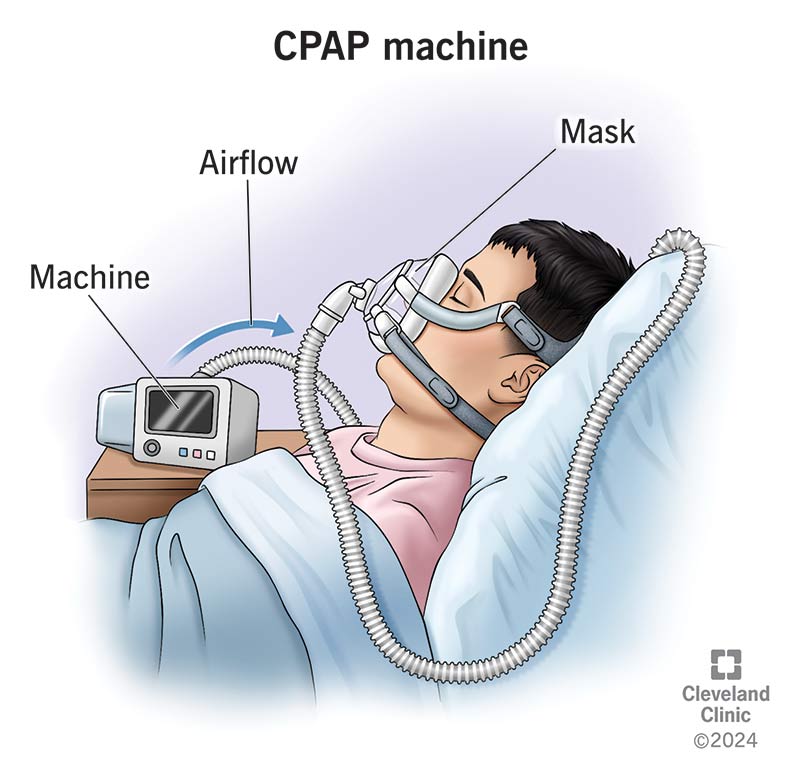A CPAP (continuous positive airway pressure) machine is one of the most common treatments for sleep apnea. It keeps your airways open while you sleep so you can receive the oxygen you need. CPAP machines can significantly improve sleep quality and reduce your risk for a number of health issues, including heart disease and stroke.
Advertisement
Cleveland Clinic is a non-profit academic medical center. Advertising on our site helps support our mission. We do not endorse non-Cleveland Clinic products or services. Policy

A CPAP (continuous positive airway pressure) machine helps treat sleep apnea. This device delivers continuous air through your mouth and/or nose to help keep your airways open while you sleep.
Advertisement
Cleveland Clinic is a non-profit academic medical center. Advertising on our site helps support our mission. We do not endorse non-Cleveland Clinic products or services. Policy
A CPAP machine includes:
Some CPAP machines have other features as well, like heated humidifiers and adjustable pressure settings.
A CPAP machine is just one type of PAP (positive airway pressure) device. CPAP is the most common among these machines. Other types include:
CPAP machines treat obstructive sleep apnea (OSA). In OSA, you briefly stop breathing while you sleep when your airways relax so much that they narrow down or completely close. This can happen hundreds of times in a single night, leading to a lack of oxygen. Untreated sleep apnea increases your risk for conditions like:
Advertisement
Untreated OSA can also increase your risk of being in a vehicle accident while driving.
Using a CPAP machine when you sleep keeps your airways open, so you don’t stop breathing.
Healthcare providers use CPAP machines for other types of breathing problems. For example, they use it for preterm infants in the neonatal intensive care unit (NICU) whose lungs haven’t yet fully developed.
A CPAP machine takes in room air, then filters and pressurizes it before delivering it through a tube and into your mask. The continuous flow of air gently keeps your tongue, uvula and soft palate from shifting too far into your airway. This stabilizes your breathing and improves your overall sleep quality.
For the sleep apnea treatment to work, you must use your CPAP machine every time you sleep. This includes at home, while traveling and during naps.
You must also clean your mask and tube every day and refill your medical device prescription when necessary to replace the mask and tube.
CPAP machines mainly vary in the type of mask you can use with it. The kind that’s best for you depends on your comfort level, breathing habits and the type of sleep apnea you have. CPAP mask types include:
Your provider will go over your options with you. They’ll also work with you to find the best type and fit of mask. Don’t hesitate to ask questions or voice your concerns. Some people end up trying a few different masks before they find the one that they like best.
Consistently using a CPAP machine to treat sleep apnea has both short- and long-term benefits.
The main benefit of using a CPAP machine is that it reduces breathing interruptions when you sleep. Because of this, short-term benefits include:
Advertisement
Long-term benefits of consistent CPAP machine use may include:
The first few times you use a CPAP machine may be difficult. Many people at first find the mask uncomfortable, claustrophobic and/or embarrassing. It may be difficult to fall asleep at first. It can also be cumbersome to travel with a CPAP machine.
Know that there are strategies for overcoming these obstacles. CPAP machines are effective, and it’s important to stick with this treatment. It may be helpful to talk to others who use CPAP machines to learn tips and tricks.
Side effects of CPAP treatment may include:
These side effects typically happen due to cold, dry air. Using a heated humidifier can often help.
CPAP masks may cause skin irritation or redness. But using the right size mask and padding can minimize these issues. Talk to your healthcare provider if you’re having bothersome side effects.
Advertisement
If you’re using a CPAP machine and have any questions or concerns, don’t hesitate to talk to your healthcare provider. It can take time to get used to a CPAP machine. If you’re having difficulties or want to try a different mask, your provider is your go-to resource.
You’ll also need to see your provider to renew your prescription for a new mask and tube periodically.
Yes. CPAP machines are the most common sleep apnea treatment. But there are alternatives, including:
Advertisement
Depending on your situation, your healthcare provider may recommend more than one therapy or strategy to address sleep apnea.
Research shows that CPAP machines are incredibly effective in treating sleep apnea when you use them consistently. CPAP is often the first line of defense against the condition.
If you have sleep apnea, a CPAP (continuous positive airway pressure) machine may be your healthcare provider’s first recommendation for treating it. Needing a to use machine to sleep may feel embarrassing or annoying. But quality sleep is vitally important to your overall health. And a CPAP machine can offer it. If you’re not comfortable with your CPAP machine, talk to your provider. There are several types of masks and machines you can try. With a little trial and error, you’ll be able to get restful shuteye.
Snoring can mess with your sleep, overall health and relationships. Cleveland Clinic experts are here to help you stop snoring and get some rest.

Last reviewed on 07/06/2024.
Learn more about the Health Library and our editorial process.